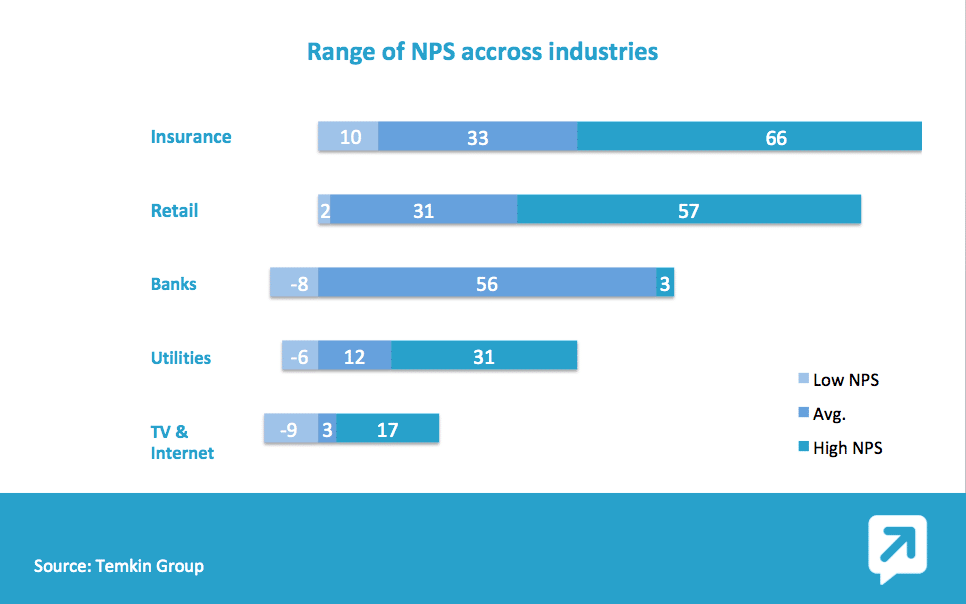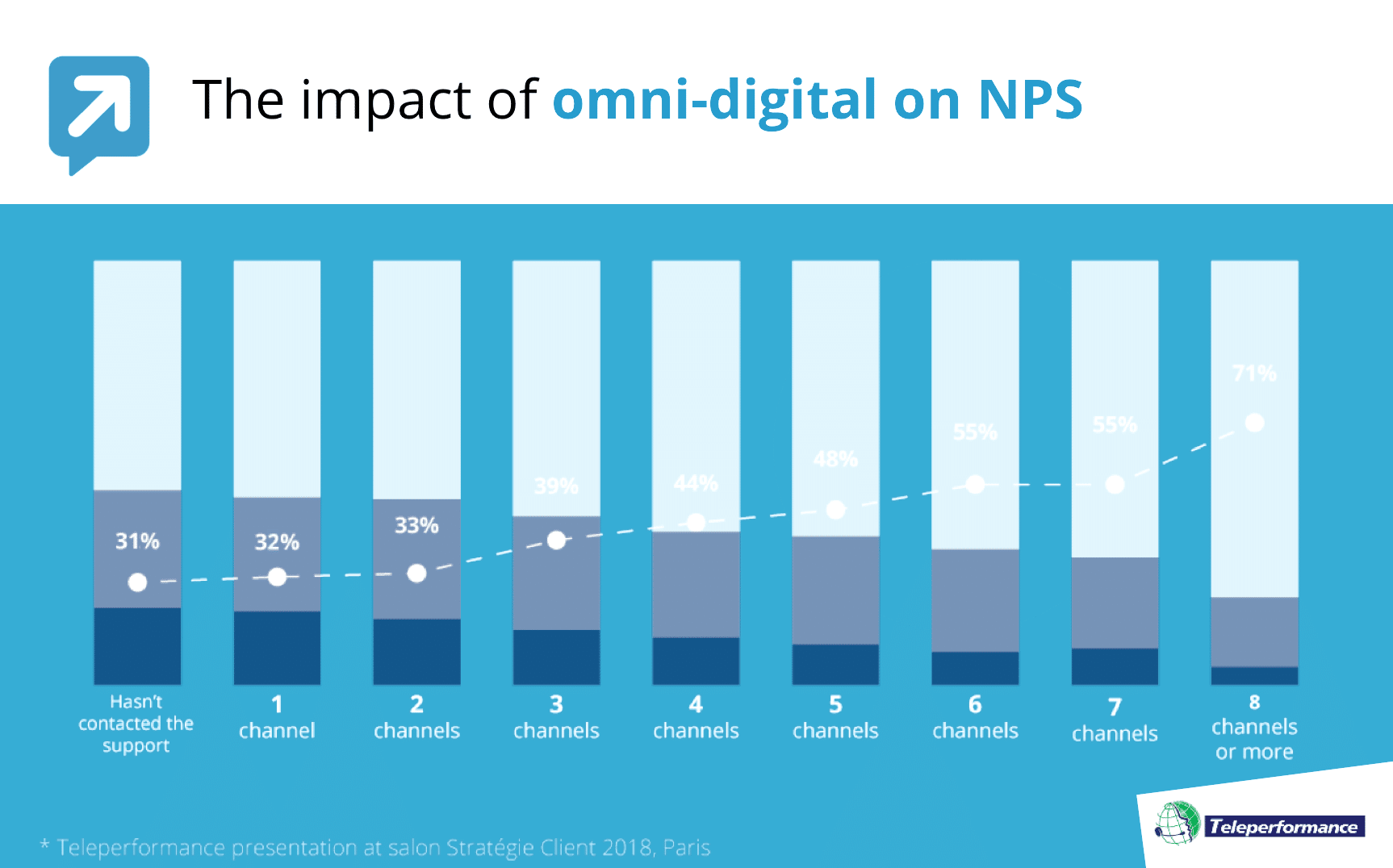Net Promoter Score or NPS is one of the most used indicators by companies across all industries to understand the loyalty and satisfaction of their customers.
Knowing that 82% of customers stopped doing business with a company after a bad experience providing a great customer experience has become a top priority for businesses to retain customers. By calculating NPS, companies can measure the impact of their strategy on customer loyalty.

I) What is NPS?
In his Harvard Business Review article, “The One Number You Need To Grow”, Fred Reichheld, a strategy consultant at Bain & Company, introduces the NPS, a new KPI measuring the global satisfaction level of his customers and more widely the customer / brand relationship.
The NPS is calculated from the following question:
- Would you recommend this company to a friend/colleague/relative ?
It enables to establish three categories of clients ranked according to their degree of enthusiasm:
0-6: Detractors – Dissatisfied customers who can negatively impact your brand
7-8: Passives – Satisfied customers who are vulnerable to competitive offerings
9-10: Promoters – The most loyal customers who will continue to buy your products while advising those around them. They will become ambassadors of your brand.
The Net Promoter Score is calculated by subtracting the percentage of detractors from the percentage of the promoters.
However, there is no ideal NPS. It differs from one industry to another. Indeed, each has its own standards in Customer Relationship. Therefore, the only reliable way to evaluate your NPS is to compare it with your direct competitors as well as the leaders of your market.
II) Why is NPS a key indicator for businesses?
1. NPS: a key KPI for businesses
For companies, the Net Promoter Score assesses customer satisfaction and loyalty but also compares with competitors or other companies operating in the same industry. By implementing a relevant customer care strategy, companies improve the satisfaction rate of their customers. If the latter increases, the referral rate also increases. Therefore, the NPS is also an indicator of the growth potential of your company or product.
According to numerous studies conducted by Harvard Business Review and Bain & Company among others, the improvement of the NPS significantly increases turnover. Indeed, companies that achieve long-term profitable growth have NPS scores twice the average. This is the case, for example, of Apple and Amazon, which have NPS scores of 89 and 69 respectively.
The NPS is one of the key indicators to consider in establishing its Customer Relationship strategy, knowing that customers are 4 times more likely to choose a brand recommended by their loved ones.
2. How to exploit NPS in its strategy?
Once your NPS is calculated, the most important is to establish a long-term strategy to track its evolution and continually improve it.
- Invite customers to recommend the company to their entourage through marketing actions. For example, by encouraging customers to leave online reviews or to sponsor their loved ones, brands can capitalize on positive NPS results.
- Build a reliable and rich database of your clients’ opinions through, among other things, attractive, clear and relevant satisfaction survey questionnaires that will make your clients want to answer.
- Mobilize all your teams and improve customer service teamwork by sharing your NPS with all departments of the company. This will allow each service to have its own lines of progress to contribute to the improvement of the NPS at their level.
- Analyze the evolution of your NPS over time. This will give you an idea of your business’ health and its ability to satisfy customers.
III) Is NPS a reliable KPI?
1) Advantages
- NPS establishes common references to categorize clients
The NPS questionnaire makes it easy to define three categories of customers: Promoters, Detractors and Liabilities. These categories make it easy to calculate each customer’s loyalty rate.
- NPS reflects growth potential of your business
NPS is not only an indicator of customer loyalty and satisfaction, it also reflects the growth potential of the company. Indeed, satisfied customers are true ambassadors for brands: they will promote the product or service to those around them.
- NPS creates a standardized framework
NPS is a standard indicator used by companies around the world. This makes it easy to compare your NPS score with that of your direct competitors and market leaders.
The NPS system has many positive points, but it also has some drawbacks.
2) Disadvantages
- NPS is not specific enough
NPS does not identify the reasons that drove some of your customers to become detractors of your brand. To know them, it is necessary to convince them to complete satisfaction surveys.
- Only NPS analysis will improve your results
The NPS questionnaire is only a first step in understanding the behavior and consumption habits of your customers. Indeed, to have an effective NPS system, it is essential to complement it with a monitoring plan that identifies the reasons that pushed some of your customers to become ambassadors of your brand and others to become your detractors. This will allow to develop an effective Customer Care Strategy over the long term.
3) Which alternatives to NPS?
- Customer Satisfaction Score (CSAT): Like NPS, CSAT can be measured very simply with a question such as “Have you been satisfied with our service?”. It therefore measures satisfaction more directly than the NPS, but it is important to make the question specific enough to exploit the results.
- Customer Effort Score (CES): born of the fact that it is more profitable, in terms of loyalty, to minimize the efforts of the customers rather than exceeding their expectations, the CES is supposed to compensate the operational deficit of the NPS. However, these two KPIs measure two different concepts, the effort and the recommendation while having the same purpose: customer loyalty.
It is important to remember that you have to combine different KPIs indicating the loyalty of your customers. It is therefore essential to consider the NPS as a complementary tool, an indicator of the growth potential of your company and not as a unique and sufficient tool.
IV) How does Dimelo contribute to the improvement of your NPS?
According to a study by Teleperformance, the percentage of promoters grows from 31% with a single channel to 71% with 8 or more channels. Thus, companies must adopt an omni-digital strategy and develop a presence on multiple channels.

Customers now expect to be able to contact brands according to their preferences, without constraints. The channel used takes second place, what matters is if the problem is solved. Companies must be present on their customers’ favorite channels and be able to offer the same quality of service. This is still a challenge: 65% of customers are frustrated with an inconsistent experience through channels. Frustrated customers are also dissatisfied customers and potential detractors of the brand.
It is therefore essential to adopt the right strategy and the right tools to meet these new customer expectations. In this sense, an Omni-Digital interactions platform contributes to this goal by making the company available on all customer-preferred channels, reducing response time and improving resource and peak of activities.
Therefore, providing an excellent customer experience must be the priority of companies. This will enable them to be able to adapt to new customer expectations and maintain high quality customer service to increase customer satisfaction and thus improve their KPIs.
Originally published Jul 10, 2018, updated Dec 30, 2022





